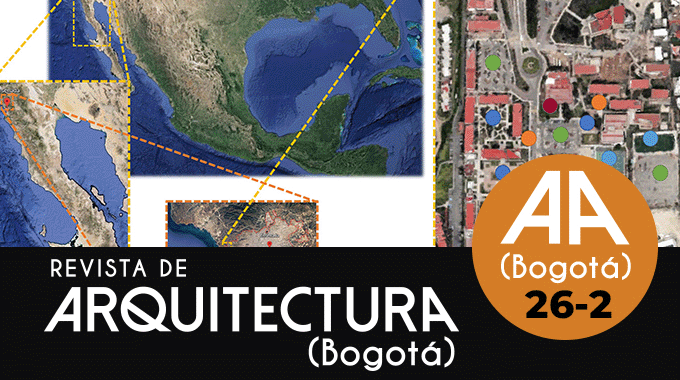

This work is licensed under a Creative Commons Attribution-NonCommercial 4.0 International License.
Revista de Arquitectura is an open access journal. More information...
Authors retain copyright and grant to the Revista de Arquitectura the right of first publication, which will be simultaneously subject to the Creative Commons (CC) BY-NC license.
Authors will sign a non-exclusive distribution license for the published version of the article by completing (RevArq FP03 Permission to Reproduce).
Self-archiving will comply with SHERPA/RoMEO guidelines and the Green classification.
To see in detail these guidelines, please consult...
Abstract
Studies on thermal comfort in outdoor spaces are fundamental to enhance the habitability of open spaces and to improve people's living conditions. However, these studies must consider the local characteristics and the specific population of the area where the studies are conducted. The objective of this paper is to evaluate human thermal sensation during the cold season, in order to calculate thermal comfort ranges for outdoor spaces, providing design indicators. For this purpose, observations were collected in various types of open spaces in the city of Ensenada, the only one in Mexico with a Mediterranean climate characterized by cold and wet winters. The evaluation was conducted using the adaptive approach and processed with the Averages of Thermal Sensation Intervals (ATSI) method. A correlational analysis was performed regarding thermal sensation with climatic variables such as air temperature, relative humidity, and wind speed. The thermal comfort range was found to be from 12.6 ºC to 23.8 ºC, values below the annual ranges calculated for Mediterranean climatic regions (21.1 ºC-29.2 ºC and 20 ºC-25 ºC) during the same study period.

References
American Society of Heating Refrigerating and Air Conditioning Engineers [ANSI/ASHRAE] 55. (2017). Thermal environmental conditions for human occupancy. https://www.ashrae.org/technical-resources/bookstore/standard-55-thermal-environmental-conditions-for-human-occupancy
Andrade, H., Alcoforado, M. J., & Oliveira, S. (2011). Perception of temperature and wind by users of public outdoor spaces: Relationships with weather parameters and personal characteristics. International Journal of Biometeorology, 55(5), 665-680. https://doi.org/10.1007/s00484-010-0379-0
Bojórquez, G. (2010). Confort térmico en exteriores: actividades en espacios recreativos, en clima cálido seco extremo [Tesis, Universidad de Colima]. https://sistemas.ucol.mx/tesis_posgrado/resumen1717.htm
Bojórquez, G., Gómez-Azpeitia, L. G., García-Cueto, O. R., Ruiz-Torres, R. P., & Luna, A. (2010). Temperatura neutral y rangos de confort térmico para exteriores, período cálido en clima cálido seco. Ambiente Construído, 10(2), 133-146. https://doi.org/10.1590/s1678-86212010000200009
Cohen, P., Potchter, O., & Matzarakis, A. (2013). Human thermal perception of Coastal Mediterranean outdoor urban environments. Applied Geography, 37(1), 1-10. https://doi.org/10.1016/j.apgeog.2012.11.001
Creative Research Systems. (2012). Sample size calculator. The Survey System. http://www.surveysystem.com/sscalc.htm
Fuentes, V. (2004). Clima y arquitectura. Universidad Autónoma Metropolitana, Unidad Azcapotzalco.
International Organization for Standardization [ISO] 10551. (1995). Ergonomics of the thermal environment - Assessment of the influence of the thermal environment using subjective judgement scales (First).
International Organization for Standardization [ISO] 7726. (1998). Ergonomics of the thermal environment — Instruments for measuring physical quantities.
International Organization for Standardization [ISO] 7730. (2005). Ergonomics of the thermal environment — Analytical determination and interpretation of thermal comfort using calculation of the PMV and PPD indices and local thermal comfort criteria.
Polade, S. D., Gershunov, A., Cayan, D. R., Dettinger, M. D., & Pierce, D. W. (2017). Precipitation in a warming world: Assessing projected hydro-climate changes in California and other Mediterranean climate regions. Scientific Reports, 7(1), 1-10. https://doi.org/10.1038/s41598-017-11285-y
Rincón-Martínez, J. C., Martínez-Torres, K. E., González-Trevizo, M. E., & Fernández-Melchor, F. (2020). Modelos matemáticos para estimar el confort térmico adaptativo en espacios interiores: Un estudio en la transición térmica de Ensenada, B.C. Ingeniería Revista Académica de la Facultad de Ingeniería Universidad Autónoma de Yucatán, 24(1), 1-17. http://www.revista.ingenieria.uady.mx/ojs/index.php/ingenieria/article/view/186
Rincón, J., Bojórquez, G., Fuentes, V., & Calderón, C. (2017). Adaptive Thermal comfort in learning spaces: A study of the cold period in Ensenada, Baja California. Journal of Natural Resources and Development, 96-107. https://doi.org/10.5027/jnrd.v7i0.12
Salata, F., Golasi, I., de Lieto Vollaro, R., & de Lieto Vollaro, A. (2015). Outdoor thermal comfort in the Mediterranean area. A transversal study in Rome, Italy. Building and Environment, 96, 46-61. https://doi.org/10.1016/j.buildenv.2015.11.023
Sanz-Cobena, A., Lassaletta, L., Aguilera, E., Prado, A. del, Garnier, J., Billen, G., Iglesias, A., Sánchez, B., Guardia, G., Abalos, D., Plaza-Bonilla, D., Puigdueta-Bartolomé, I., Moral, R., Galán, E., Arriaga, H., Merino, P., Infante-Amate, J., Meijide, A., Pardo, G., … Smith, P. (2017). Strategies for greenhouse gas emissions mitigation in Mediterranean agriculture: A review. Agriculture, Ecosystems and Environment, 238(January 2017), 5-24. https://doi.org/10.1016/j.agee.2016.09.038
Yahia, M. W., & Johansson, E. (2013). Evaluating the behaviour of different thermal indices by investigating various outdoor urban environments in the hot dry city of Damascus, Syria. International Journal of Biometeorology, 57(4), 615-630. https://doi.org/10.1007/s00484-012-0589-8
































